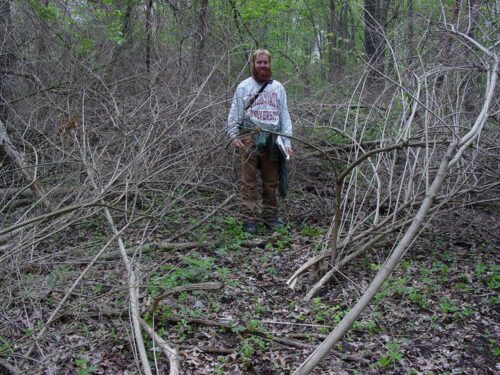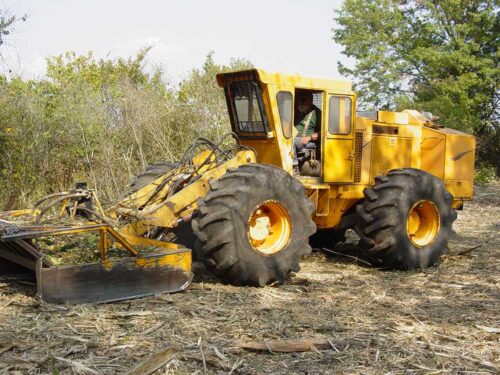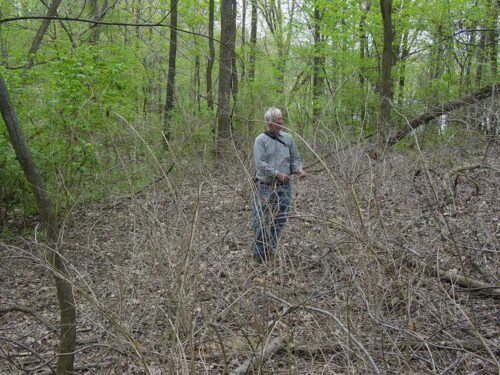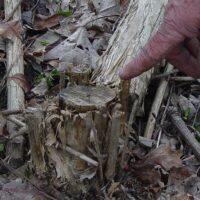 Purdue University - Extension - Forestry and Natural Resources
Purdue University - Extension - Forestry and Natural Resources
Got Nature? Blog
Question: Once I’ve pulled or cut, and have treated the bush honeysuckle stumps, can it be left to decay, particularly if not piled directly on the ground in a woodland?
When deciding what methods to use to control invasive brush on your property, one of the questions often asked is “what should I do with the cut tops?” (Fig. 1) A similar question we often get from landowners planning to have timber harvested from their woods is “what should I or the loggers do with the tree tops that are left?” The simple answer is just leave them where they are and they will decay over time and gradually disappear. If you have many acres to treat for invasive brush infestation, then this is good news. But there may be other factors to consider. In this blog post I will try to unpack those other considerations to help you decide what to do.To start let’s do a quick review of the more common methods of controlling invasive brush and the resulting ground conditions left in their aftermath. By invasive brush, I am primarily talking about non-native brush species that have invaded our native habitats, including the woods, and that are wreaking ecological havoc and degrading the productive potential of those lands for wildlife, timber, and recreation. The more common species include Asian bush honeysuckle, autumn olive, multiflora rose and callery pear (aka Bradford, Cleveland, ornamental pear).There are a variety of methods, tools, equipment, and chemicals used for invasive brush control. Other blog posts cover many of these methods, so I will not describe their use except to show what a site looks like in their wake. Large equipment like skid steer mounted mulchers or brush cutters or the industrial size Hydroax (Fig. 2) thoroughly chop up or mulch all that brush material and leave a fairly clean site (Fig. 3). In this case, there are no brush tops to dispose of. If you are wanting a very “clean” site, then hiring a dozer may be what you’re after. All those tops can then be piled and burned. The bare soil can then be planted in desired vegetation.Most forest landowners are going to use smaller scale methods and equipment, especially in the woods. Spraying herbicide on the foliage (Fig. 4) or applying it as a basal bark application to the lower stems leaves dead standing shrubs. Using brushsaws and chainsaws to cut the shrubs close to the ground and then applying a concentrated herbicide to the stump (commonly called cut-stump treatment, Fig. 5) leaves severed brush tops lying about. Even the less conventional prescribed fire will almost always leave standing dead shrub tops.

Figure 3. Once dominated by large non-native bush honeysuckle shrubs, this site was recently cleared by large brush cutting equipment. (click to enlarge)
For many people, the problem with all these dead shrubs lying about is aesthetic – it makes the property look cluttered, at best, if not downright unsightly. If aesthetics were the only concern, we might be able to talk ourselves into putting up with it for several years until the dead shrub tops begin to decay and break down and new vegetation grows up to mask them.
But are there other concerns that would justify expending time and money to dispose of the dead tops?
Access may be another consideration, especially in high use areas such as those used frequently for recreation like hunting or hiking. Depending on habitat restoration plans, you may want access to those areas to seed or plant native trees, shrubs, forbs or grasses. Especially if you are using specialized planting or seed drill equipment, the site may need to be relatively clear of obstructions and debris.
How does leaving dead invasive shrub tops impact this restoration process?
The removal of invasive species should not be the end goal in managing habitat, but only an important step in restoring a healthy native plant community. How does leaving dead invasive shrub tops impact this restoration process? Researchers in Ohio found in the short term that cutting and applying herbicide to the stumps of Amur honeysuckle (Asian bush honeysuckle) and leaving the tops in place allowed more sunlight to reach the forest floor than the basal bark treatment which left dead tops standing in place (Cipollini et al. 2009). This resulted in greater height growth for native herbaceous plant growth. However, in the presence of deer browse, the native plants suffered less deer damage in the basal bark treatment area, due to the greater protection afforded by the standing dead tops, compared to the areas where tops were cut. One might surmise that even leaving cut tops in place may provide some protection from deer browse compared to complete removal of the tops. Joshua Shields and fellow researchers at Purdue University (2014) studied the impact of clearing bush honeysuckle in a forest environment on white footed mice populations. They found that where bush honeysuckle was cut and the tops removed from the site that white footed mice numbers increased, compared with mice numbers in nearby standing live bush honeysuckle. They did not, however, test how leaving cut honeysuckle tops on site would affect mice populations.
Many people may cringe at the thought of increasing numbers of mice, but mice in their natural environment are an important source of food for many predators, including hawks, owls, fox, mink, weasels, and bobcats. In a study comparing the cut stump method (cutting the stems and treating the stump with herbicide) and the use of a mulching head attachment on a skid steer for controlling bush honeysuckle, Purdue researchers found no difference in the growth and recovery of the native plants (Graham et al. 2018). However, the mulching head treatment resulted in a greater abundance of garlic mustard, a non-native invasive biennial herb. Invasive brush control treatments resulting in greater soil disturbance often lead to a second wave of invasive plants that need follow-up treatment.
So what can we conclude from all this?
There are benefits and drawbacks to removing invasive brush tops when managing invasive species on your property. It really depends on your management objectives. It can even vary depending on the specific location on your property. In some select areas it may be very beneficial to remove the tops while in most other areas you can just let them rot in place. The important thing is that you have a well thought out plan for managing the invasive species on your property and that you are working your plan. As you work your plan you will begin seeing the positive results as native plant communities begin to make a comeback.
Resources:
A Woodland Management Moment, Playlist, Purdue Extension – Forestry and Natural Resources (FNR) Youtube Channel
Conservation Tree Planting: Steps to Success, Purdue Extension – FNR Youtube Channel
Invasive Species, Playlist, Purdue Extension – FNR Youtube Channel
Woodland Stewardship for Landowners, Playlist, Purdue Extension – FNR Youtube Channel
Invasive Plant Species Identification, Video, Purdue Extension – FNR Youtube Channel
Report Invasive Species, Purdue Invasive Species
The GLEDN Phone App – Great Lakes Early Detection Network
EDDMaps – Early Detection and Distribution Mapping System
Indiana Department of Natural Resources: Invasive Species
Indiana Invasive Species Council
Cooperative Invasive Species Management Area (CISMA)
Invasive plants: impact on environment and people, The Education Store, Purdue Extension’s resource center
A Landowner’s Guide to Sustainable Forestry: Part 7: Managing for a Diversity of Value-Added Forest Products, The Education Store
Investing in Indiana Woodlands, The Education Store
Woodland Invaders, Got Nature? Blog, Purdue Extension – FNR
Ron Rathfon, Regional Extension Forester, Sourthern Indiana Purdue Agriculture Center (SIPAC)
Purdue Forestry and Natural Resources

Recent Posts
- Report Spotted Lanternfly – Purdue Landscape Report
Posted: April 10, 2024 in Alert, Forestry, Invasive Insects, Plants, Wildlife, Woodlands - Declining Pines of the White Variety – Purdue Landscape Report
Posted: in Alert, Disease, Forestry, Plants, Wildlife, Woodlands - Are you seeing nests of our state endangered swan? – Wild Bulletin
Posted: April 9, 2024 in Alert, Forestry, How To, Wildlife - Cicadas in Spring! – Purdue Landscape Report
Posted: in Forestry, Plants, Safety, Wildlife - New Deer Impact Toolbox
Posted: April 7, 2024 in Forestry, Land Use, Plants, Publication, Safety, Wildlife, Woodlands - 2024-25 Fishing Guide now available – Wild Bulletin
Posted: April 4, 2024 in Alert, Aquaculture/Fish, Aquatic/Aquaculture Resources, How To, Ponds, Wildlife - Help Research Chronic Wasting Disease – Wild Bulletin
Posted: April 3, 2024 in Disease, Forestry, How To, Safety, Wildlife, Woodlands - Indiana Reptiles and Amphibians – IFWOA Webinar
Posted: April 1, 2024 in Forestry, How To, Webinar, Wildlife, Woodlands - Birding through the Seasons – IFWOA Webinar
Posted: in Forestry, How To, Webinar, Wildlife, Woodlands - Look Out for Invasive Carp in Your Bait Bucket – Wild Bulletin
Posted: March 31, 2024 in Alert, Aquaculture/Fish, Aquatic/Aquaculture Resources, Invasive Animal Species, Wildlife
Archives
Categories
- Alert
- Aquaculture/Fish
- Aquatic/Aquaculture Resources
- Ask the Expert
- Christmas Trees
- Community Development
- Disease
- Drought
- Forestry
- Forests and Street Trees
- Gardening
- Got Nature for Kids
- Great Lakes
- How To
- Invasive Animal Species
- Invasive Insects
- Invasive Plant Species
- Land Use
- Natural Resource Planning
- Nature of Teaching
- Plants
- Podcasts
- Ponds
- Publication
- Safety
- Timber Marketing
- Uncategorized
- Urban Forestry
- Webinar
- Wildlife
- Wood Products/Manufacturing
- Woodland Management Moment
- Woodlands



